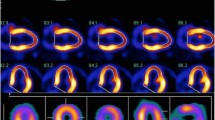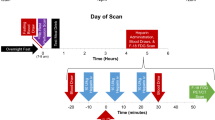Abstract
In an investigation of myocardial metabolic abnormalities in hypertrophic myocardium, the myocardial glucose metabolism was evaluated with F-18-fluorodeoxyglucose (FDG) positron emission tomography (PET) in 32 patients with hypertrophie cardiomyopathy, and the results were compared with those in 9 patients with hypertensive heart disease. F-18-FDG PET study was performed in the fasting and glucose-loading states. The myocardial regional %dose uptake was calculated quantitatively. The average regional %dose uptake in the fasting state in the patients with asymmetric septal hypertrophy and dilated-phase hypertrophie cardiomyopathy was significantly higher than that in the patients with hypertensive heart disease (0.75 ± 0.34%, 0.65 ± 0.25%, and 0.43 ± 0.22%/100 g myocardium, respectively). In contrast, the average %dose uptake in the glucose-loading state in the patients with asymmetric septal hypertrophy and dilated-phase hypertrophie cardiomyopathy was not significantly different from that in patients with hypertensive heart disease (1.17 + 0.49%, 0.80 ± 0.44% and 0.99 ± 0.45%, respectively). The patients with apical hypertrophy had also low %dose uptake in the fasting state (0.38 ± 0.21%) as in the hypertensive heart disease patients, so that the characteristics of asymmetric septal hypertrophy and dilatedphase hypertrophic cardiomyopathy are considered to be high FDG uptake throughout the myocardium in the fasting state. Patients with apical hypertrophy are considered to belong to other disease categories metabolically. F-18-FDG PET study is useful in the evaluation of the pathophysiologic diagnosis of patients with hypertrophie cardiomyopathy.
Similar content being viewed by others
References
Henry WL, Clark CE, Epstein SE. Asymmetric septal hypertrophy: echocardiographic identification of the pathognomonic anatomic abnormality of IHSS.Circulation 47: 225–233, 1973.
Maron BJ, Bonow RO III, Cannon RO, Leon MB, Epstein SE. Hypertrophic cardiomyopathy: interrelations of clinical manifestations, pathophysiology and therapy.N Engl J Med 316: 780–789, 844–852, 1987.
Shapiro LM, McKenna WJ. Distribution of ventricular hypertrophy in hypertrophic cardiomyopathy: a two-dimensional echocardiographic study.J Am Coll Cardiol 2: 437–444, 1983.
Yamaguchi H, Ishimura T, Nishiyama S, Nagasaki F, Nakanishi S, Takaku F, et al. Hypertrophic nonobstructive cardiomyopathy with giant negative T waves (apical hypertrophy): ventriculographic and echocardiographic features in 30 patients.Am J Cardiol 44: 401–412, 1979.
Louie EK, Maron BJ. Apical hypertrophic cardiomopathy: clinical and two-dimensional echocardiographic assessment.Ann Intern Med 106: 663–670, 1987.
Nagata S, Park Y, Minamikawa T, Yutani C, Kamiya T, Nishimura T, et al. Thallium perfusion and cardiac enzyme abnormalities in patients with familial hypertrophie cardiomyopathy.Am Heart J 109: 1317–1322, 1985.
Ten Gate FG, Roelandt J. Progression to left ventricular dilatation in patients with hypertrophie obstructive cardiomyopathy.Am Heart J 762–765, 1979.
Spirito P, Maron BJ, Bonow RO, Epstein SE. Occurrence and significance of progressive left ventricular wall thinning and relative cavity dilatation in hypertrophie cardiomyopathy.Am J Cardiol 59: 123–129, 1987.
Nishimura T, Nagata S, Uehara T, Hayashida K, Mitani I, Kumita S. Assessment of myocardial damage in dilatedphase hypertrophie cardiomyopathy by using indium-111-antimyosin Fab myocardial scintigraphy.J Nucl Med 32: 1331–1337, 1991.
Maron BJ, Epstein SE. Hypertrophic cardiomyopathy. Recent observations regarding the specificity of three halfmarks of the disease: asymmetric septal hypertrophy, septal disorganization and systolic anterior motion of the anterior mitral leaflet.Am J Cardiol 45: 141–154, 1980.
Wigle ED, Sasson Z, Henderson MA, Ruddy TD, Fulop J, Rakowski H, et al. Hypertrophic cardiomyopathy. The importance of the site and the extent of hypertrophy. A review.Prog Cardiovasc Dis 28: 1–81, 1985.
Maron BJ, Gottdiener JS, Epstein SE. Patterns and significance of distribution of left ventricular hypertrophy in hypertrophie cardiomyopathy: a wide angle, two dimensional echocardiographic study of 125 patients.Am J Cardiol 48: 418–428, 1981.
Tamaki N, Yonekura Y, Kawamoto M, Nagata Y, Sasayama S, Takahashi N, et al. Simple quantification of regional myocardial uptake of fluorine-18-fluorodeoxyglucose in the fasting condition.J Nucl Med 32: 2152–2157, 1991.
Hecht GM, Klues HG, Roberts WC, Maron BJ. Coexistence of sudden cardiac death and end-stage heart failure in familiar hypertrophie cardiomyopathy.J Am Coll Cardiol 22: 489–497, 1993.
McKenna W, Beanfield J, Farugui A, England D, Oakley C, Goodwin J. Prognosis in hypertrophie cardiomyopathy: role of age and clinical, electrocardiographic and hemodynamics feature.J Cardiol 41: 532–538, 1981.
Roffland MJ, Waldstein DJ, Vus J, J ten Cate F. Prognosis in hypertrophie cardiomyopathy observed in a large clinic population.Am J Cardiol 72: 939–943, 1993.
Maron BJ, Roberts WC, Epstein SE. Sudden death in hypertrophie cardiomyopathy: a profile of 78 patients.Circulation 65: 1388–1394, 1982.
Betocchi S, Bonow RO, Bacharach SL, Rosing DR, Maron BS, Green MV, et al. Isovolumic relaxation period in hypertrophie cardiomyopathy: assessment by radionuclide angiography.J Am Coll Cardiol 7: 74–81, 1986.
Spirito P, Maron BJ. Relation between extent of left ventricular hypertrophy and diastolic filling abnormalities in hypertrophie cardiomyopathy.J Am Coll Cardiol 15: 808–813, 1990.
Bonow RO, Dilsizian V, Rosing DR, Maron BJ, Bacharach SL, Green MV. Verapamil-induced improvement in left ventricular diastolic filling and increased exercise tolerance in patients with hypertrophie cardiomyopathy: shortand long-term effects.Circulation 72: 853–864, 1985.
Grover-McKay M, Schwaiger M, Krivokapich J, Perloff JK, Phelps ME, Schelbert HR, et al. Regional myocardial blood flow and metabolism at rest in mildly symptomatic patients with hypertrophie cardiomyopathy.J Am Coll Cardiol 13: 317–324, 1989.
Nienaber CA, Gambir SS, Mody FV, Ratib O, Huang S, Phelps MZ, et al. Regional myocardial blood flow and glucose utilization in symptomatic patients with hypertrophic cardiomyopathy.Circulation 87: 1580–1590, 1993.
Kagaya Y, Ishide N, Takayama D, Kanno Y, Yamane Y, Shirato K. Differences in myocardial fluoro-deoxyglucose in young and older patients with hypertrophie cardiomyopathy.Am J Cardiol 69: 242–246, 1992.
Shimonagata T, Nishimura T, Uehara T, Hayashida K, Kumita S, Ohno A, et al. Discrepancies between myocardial perfusion and free fatty acid metabolism in patients with hypertrophie cardiomyopathy.Nucl Med Comm 14: 1005–1013, 1993.
Kurata C, Tawarahara K, Taguchi K, Ashina S, Kobayashi A, Yamazaki N, et al. Dual-tracer autoradiographic study with thallium-201 and radioiodinated fatty acid in cardiomyopathic hamster.J Nucl Med 30: 80–88, 1989.
Tamaki N, Fujibayashi Y, Nagata Y, Yonekura Y, Konishi J. Radionuclide assessment of myocardial fatty acid metabolism by PET and SPECT.J Nucl Cardiol 2: 256–266, 1995.
Nishimura T. Approaches for identity and characterize hypertrophie myocardium.J Nucl Med 34: 1013–1019, 1993.
Perrone-Filardi P, Bacharach SL, Dilsizian V, Panza JA, Maurea S, Bonow RO, et al. Regional systolic function, myocardial blood flow and glucose uptake at rest in hypertrophie cardiomyopathy.Am J Cardiol 72: 199–204, 1993.
Pither D, Wainwright R, Maisey M, Curry P, Lowton E. Assessment of chest pain in hypertrophie cardiomyopathy using exercise thallium-201 myocardial scintigraphy.Br Heart J 44: 650–655, 1980.
Cannon RO III, Dilsizian V, O’Gara PT, Underson JE, Schenke BA, Quyyumi A, et al. Myocardial metabolic, hemodynamic, and electrocardiographic significance of reverse thallium-201 abnormalities in hypertrophie cardiomyopathy.Circulation 83: 1660–1667, 1991.
O’Gara PT, Bonow RO, Maron BJ, Damske BA, Lingen AV, Bacharach SL, et al. Myocardial perfusion abnormalities in patients with hypertrophie cardiomyopathy: Assessment with Thallium-201 emission-computed tomography.Circulation 76: 1214–1223, 1987.
Maron BJ, Epstein SE, Roberts WC. Hypertrophic cardiomyopathy and transmural myocardial infarction without significant atherosclerosis of the extramural coronary arteries.Am J Cardiol 43: 1086–1102, 1979.
Maron BJ, Wolfson JK, Epstein SE, Robert WC. Intermural (“small vessel”) coronary artery disease in hypertrophic cardiomyopathy.J Am Coll Cardiol 8: 545–557, 1986.
Opherk D, Mall G, Zebe H, Schwarz F, Weihe E, Manthery J, et al. Reduction of coronary reserve: a mechanism for angina pectoris in patients with arterial hypertention and normal coronary arteries.Circulation 69: 1–7, 1984.
Cannon RO, Rosing DR, Maron BJ, Leon MB, Bonow RO, Watson RW, et al. Myocardial ischemia in patients with hypertrophie cardiomyopathy: contribution of inadequate vasodilator reserve and elevated left ventricular filling pressures.Circulation 71: 234–243, 1985.
Marcus ML, Koyanagi S, Harrison CJ, Doty DB, Hiratzka LF, Eastham CL. Abnormalities in the coronary circulation that occur as a consequence of cardiac hypertrophy.Am J Med 75: 62–66, 1983.
Camici P, Chrisatti G, Lorenzoni R, Bellina R, Gistri R, Italiani G, et al. Coronary vasodilation is impaired in both hypertrophied and nonhypertrophied myocardium of patients with hypertrophie cardiomyopathy: A study with nitrogen-13 ammonia and positron emission tomography.J Am Coll Cardiol 17: 879–886, 1991.
Hoffman EJ, Huang SC, Phelps ME. Quantitation in Positron Emission Computed Tomography: 1. Effect of Object Size.J Comput Assist Tomogr 3: 299–308, 1979.
Author information
Authors and Affiliations
Corresponding author
Rights and permissions
About this article
Cite this article
Uehara, T., Ishida, Y., Hayashida, K. et al. Myocardial glucose metabolism in patients with hypertrophic cardiomyopathy: Assessment by F-18-FDG PET study. Ann Nucl Med 12, 95–103 (1998). https://doi.org/10.1007/BF03164836
Received:
Accepted:
Issue Date:
DOI: https://doi.org/10.1007/BF03164836




